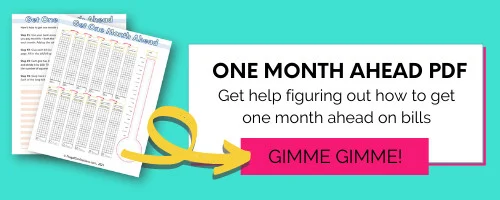If you knew you had enough for this month’s bills AND next month’s in checking, would you sleep better at night? You bet. How to get one month ahead on bills.
Do your palms get a little sweaty as you manually press “pay” for your bills because you’re not always sure you’ll have enough to cover things?

Cutting things too close each month pretty much sucks.
Which is why I’m going to show you how to get one month ahead on bills.
Doing this will allow you to:
- Set up automatic bill payments in confidence.
- Stop those stress checks of your account to make sure you’ve got enough in them.
- Stop over-withdrawal fees on your account.
- Stop late fees from providers and services.
- Sleep better at night (seriously).
Ready to stop checking your account a bazillion times to make sure there’s enough to cover things?
Let’s get to it!
How to Get One Month Ahead on Bills
How much money should you have a month after bills?
While most Americans might tell you that you should be around $0 (with a small buffer to spare), the reality is, that cutting things so close in between paychecks really increases financial stress.
And who needs more of that?
Getting an entire month ahead of your bills is not the popular thing to do.
But it has so many flippin’ benefits, that I’m going to REALLY encourage you to do so (need to know more of why to do it? Keep reading all the way to the end).
Step #1: Round Up All of Your Bills
You need to figure out how much your target amount of money is that you need to keep in your checking account – above and beyond what goes in there to pay for this month’s bills – in order to put yourself a full month ahead.
To do this, you’ll want to round up estimate bill amounts for every bill that comes in the door over one month (using a monthly bill pay checklist PDF? Now's the time to pull that out).
You’ll want to account not only for the “typical” bills each month but also for the not-so-obvious smaller ones.
So not only these ones:
- Mortgage or rent
- Car payments
- Gas
- Utilities
- Groceries
- Tuition payments
- Debt payments (credit card minimums, student loan debt minimums, and other debt minimums)
- Insurance premiums (auto, home/renter’s, etc.)
But also things like:
- Subscriptions (apps, magazines, food delivery services, etc.)
- Memberships
- etc.
Basically, any bills and costs that, even if the paychecks stopped coming next month, you’d still have to pay.
Some bills are “fixed”, meaning, the amount you send in each month is the same no matter what time of year (such as your rent payment).
Other bills are variable, which means they vary either due to how much you choose to spend that month (like for groceries), or differences in usage and charges due to seasonality (for example, a home heated by natural gas will incur a much higher natural gas bill in the winter months than in the summer months).
For variable bills, you can either:
- Just use last month’s amount
- Log into your service provider account, add up the last 12 months of bills, and divide by 12 to get an average monthly cost
It just depends on how tedious and accurate you want to get.
Step #2: Add Up Your Total Target Amount – Your New Checking Account Baseline
Take all of that information you just put together and add up how much one month’s worth of bills looks like for you.
Is it $5,346? $3,426? $9,456?
Whatever the number, this is the total target amount you’ll need to set aside in your checking account to become one month ahead on your bills.
Pssst: does your number scare you? Stick with me here, because I’m going to not only show you how to do this logistically, but give you ideas for how to make it happen – you know, actually save up to get a month ahead.
This is what you want your new checking account baseline to be. Meaning, your new “0” in checking actually will become this number and when you hit this number or get near to it, you know you’ve spent all you can until your next paycheck or until the next month.
That’s because you want this month to stay in your checking account always so that you’ll always be one month ahead.
Pssst: are you worried about a lump sum of money hanging out in checking when it could be earning interest in a savings account? Here’s my article on interest-bearing checking accounts, which you might want to look into.
Step #3: Set Up Your One-Month-Ahead Tracker
Now you’ve got the lay of the land. You know what bills you pay each month, at least an estimate of how much they cost, and you calculate your new checking account baseline.
Bravo, you!
It’s not likely you’ll be able to save up for that total amount all at once (though if you can, then that’s awesome!).
SO, we want to set up a tracker for you that will help you set and meet mini-goals for each bill, then track your overall goal: to get one month ahead of your bills in your checking account.
That’s why I created this One-Month-Ahead Savings Tracker, which lets you fill in your goal for each of 14 different bills, the amount you’ll need to save for each and track your overall target goal at the same time.
For each bill, you’ll fill in:
- What the bill is (mortgage, car insurance, utilities, etc.)
- How much the bill is (from the estimate above)
- What each square on the grid is worth
Each grid has 100 squares in it, so you will take the amount for that bill, and divide it by 100. That tells you what each square is “worth”, and you’ll color in the number of squares you’ve saved up for as you work on that mini-goal.
For example, let’s say the first mini-goal you have within your one-month-ahead goal is to save up enough to cover the cost of your $475 car payment. You would label “car payment” in the first grid, with $475 as the amount.
Then, you would divide the $475/100, and see that each square in that first grid is worth $4.75. Write that value in the key below the grid.
Each time you send money into your checking account as part of your money goal to get one month ahead, you’ll color in how many squares you’ve done. And when you color in all of the squares? You’ve put the amount you need for this bill into your checking and it’s time to move on to your next bill.
In this car payment example, let’s say you put in $200 extra dollars last week. You would color in a little over 42 squares ($200 divided by $4.75). It’s a nice visual snapshot of the progress you’re making.
Hint: what happens if you have more than 14 bills to save up for? Go ahead and group a few of the bills together with a name you’ll recognize. For example, you could group together Water/Natural Gas/Trash costs as “utilities”, and add up the estimates for all three to be one grid. Or, you could group together your car payment with your car insurance (and even gas) in one grid. It’s up to you.
Step #4: How to Come Up with the Extra Money
You might be thinking, “Gee, this is great Amanda…but how am I supposed to come up with the actual extra money to put into my checking account?!?”
I hear you. This section is all about that!
Here are 4 solid ideas for how you can come up with money to get one month ahead on your bills.
Psst: you'll also want to check out these 14 personal money management tips.
Idea #1: Do a No-Spend Challenge
Ever heard of a no-spend challenge?
It’s when you stop spending money for a length of time (one weekend, one week, two weeks…however long you’d like), and then dedicate the money you saved to one of your savings goals.
This is an excellent opportunity to help you get one month ahead on bills!
Here are some resources:
- No Spending Challenge (Complete Guide)
- 17 No Spend Challenge Ideas
- 11 No Spend Challenge Trackers and Apps
Idea #2: Track and Use Your Extra Paychecks
If you’re paid bi-weekly, then there are actually two months in a year where you’ll receive 3 paychecks.
I challenge you to take at least half of that “extra” paycheck and sock it away towards your goal to get one month ahead on bills.
You have to maneuver a bit to make this one work, but you can do this.
Idea #3: Cut Your Regular Expenses
If you can cut your expenses? Then that has a dual, positive effect: you can both save up for your goal quicker, and you’ll need to save up less to get one month ahead.
Here are some resources to help you:
Idea #4: Budget it In
Fill out a weekly budget worksheet, and actually put a line in for “get one month ahead”.
Just as if it were a bill to be paid. And you’ll put the money towards whichever particular mini-goal (bill) you’re working on at the moment.
What Getting One Month Ahead Will Do for You
Getting one month ahead of your bills can do wonders for both your finances, your relationship (less financial fights, anyone?), and your relationship with money.
This will help you to:
- Get ahead financially – no more putting out random financial fires like it’s your night job
- Stop checking your checking account more than “normal”
- Stop sweating when different bills are due, like around the 15th of the month when the mortgage comes out
Forget about manually pressing “pay now” on each of your bills with sweaty palms. And set your sights on more than just keeping enough in your checking to cover any overdraft fees. Instead, follow through with how to get one month ahead on bills. You’ll seriously cut down on financial stress, and your relationship with money will reach new levels, too!



Vanessa
Saturday 6th of April 2024
How to get one month ahead on Bills